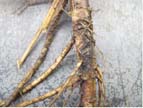 Protecting Our Own & Neighbors’ Crops: Brown Root Rot
Protecting Our Own & Neighbors’ Crops: Brown Root Rot
Brown root rot, caused by the fungus Phoma sclerotioides, was first identified in New York State in 2003 in Clinton County. The cold-weather disease damages alfalfa crops, a valuable dairy and livestock feed crop and cash crop. BRR is currently found in NY and the Northeastern U.S., WY, and in areas of Canada. NNYADP research has confirmed areas of BRR by field survey, helped farmers begin to recognize the disease, and has begun creating management strategies. Click on the links below to learn more.
Brown Root Rot of Alfalfa: NNY Research
2019: 2019: Brown Root Rot of Alfalfa: Field Rotation and Preparation
. Third Production Year Yield of Populations Developed After Exposure to Brown Root Rot Fungus and Ice Sheeting; Fact Sheet
2nd Production Year: Project Results
2015: BRR of Alfalfa: Challenges and Opportunities
New Brown Root Rot Lab Test has Northern NY Roots, June 2014
BRR of Alfalfa: Suspect Sample Submission Guidelines, June 2014
NNY Research Advancing Battle vs. Brown Root Rot, November 2013
Alfalfa Germplasm from the Presence of Brown Root Rot Fungus and Ice Sheeting, NNYADP, 2012
Assess Alfalfa Stands for Brown Root Rot This Spring, 2008
Root rot may hinder alfalfa crops, June 2011 Watertown Times
BRR: A Serious Forage Crop Disease is Widespread in Northeastern US – Nov 2007 Science Daily
2009: Management of BRR on Alfalfa in NNY
2008: Management of BRR of Alfalfa and Forage Grasses
Scientists detect fungus in farm fields, Nov 2007 Associated Press
Watch for Brown Root Rot in New York Alfalfa, May 2011 Hay & Forage Grower